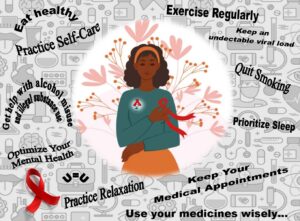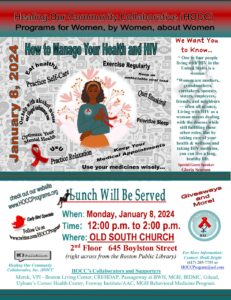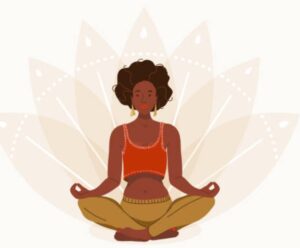

We want you to know that one in four people living with HIV in the United States is a woman and in 2021, 30.2% of all new HIV infections in Massachusetts were women. This recent shift in in the numbers of women currently becoming infected and at risk for HIV also lends to a wider lens to just see how women and men have very different experiences, health outcomes, and health challenges living with HIV. Social barriers such as racism, discrimination, and HIV stigma have a major impact on health and well-being. These factors prevent some women from seeking and receiving high-quality health care, including HIV testing, treatment, and other prevention services. Addressing these barriers and encouraging safe and supportive communities can help improve health outcomes for women. There is also another significant hurtle for women who live with HIV and that is the role of women in general. What we know is the role of women in general are that of mothers, grandmothers, caretakers, spouses, sisters, employees, friends, and neighbors — often all at once. Living with HIV as a woman means dealing with the disease while still fulfilling these other roles. Women may delay ART initiation because of social obligations, pregnancy and socioeconomic factors. Historically, self-care is often not a priority for women which includes their managing their HIV – this requires special attention and devotion to self. Understanding gender norms and gender inequality must be considered for healthier outcomes for women.
Men and women are clearly affected differently with HIV and women’s immune systems may respond differently to the virus because of hormonal influence. Women may also experience stronger side effects when using ARV drugs, such as central nervous system and gastrointestinal symptoms, which could then lower their ARV adherence . Survival of HIV infected patient from the point of HIV diagnosis to AIDS within a comparable clinical care setting is affected mostly by the time of HIV diagnosis and other differences like age, gender, race and behavioral factors may also play a role on survival Also the differential use of ARV drugs for purely social economic reasons may lead to survival disadvantages for women.
Women have been affected by HIV since the beginning of the epidemic and face unique challenges in accessing optimal prevention, care and treatment resources.
Below is a list of the How Does HIV Affect Women Differently?
- 80% of women living with HIV said they had experienced some form of violence or trauma
- 55% of women and 20% of men living with HIV infection experience intimate partner violence (IPV) and that 24% of women experience abuse by their partners after disclosing their HIV serostatus.
- PrEP (pre-exposure prophylaxis) reduces the risk of getting HIV from sex by about 99% yet PrEP use among women is very low – Only 7% PrEP (Pre-Exposure Prophylaxis)
- 56% of women living with HIV report mental health issues made it harder to address their HIV-related needs
- Most women who have HIV know that they are HIV positive, but some women are not getting the HIV care and treatment they need.
- 65% of women living with HIV are dealing with comorbidities
- 69% experienced stigma in their personal lives and 61% in healthcare settings
- 60% experienced self-stigma
- Women living with HIV experience depression, anxiety, and posttraumatic stress symptoms at higher rates than their male counterparts and more often than HIV-unaffected women. These mental health issues affect not only the well-being and quality of life but have implications for HIV management and transmission prevention.
- Compared to all people living with HIV, women have lower viral suppression rates.
- Cervical Cancer and HIV: Women with HIV have a higher risk of cervical cancer. It is important that they be screened regularly for this disease.
- HIV medicines can also put women at higher risk than men of getting fat buildup throughout their bodies or of having pancreas problems.
- HIV Medicine Side Effects and Drug Interactions: HIV medicine works as well for women as it does for men. However, some medicines can cause different side effects in women than men. For example, the HIV medicine ritonavir (also called Norvir or RTV) may cause more nausea and vomiting in women.
- Lack of housing. Homeless women have less access to care. They may not be able to stick with care routines because of irregular meals or not having proper places to store medicines.
- Women with HIV also may face also other health concerns as they age. These include:
- Gynecological Health Issues and HIV: Gynecological problems are common among women with HIV. Some of the issues women may experience are:
- Problems related to sexually transmitted diseases (STDs)—STD screening and treatment are important for all women. However, they are especially important for women with HIV because some STDs, like genital herpes, pelvic inflammatory disease (PID), and chancroid, can happen more often and be more severe and/or harder to treat. Also, having HIV and other STDs may increase the risk of HIV transmission to sexual partners.
- Vaginal yeast infections—In women with HIV, vaginal yeast infections can occur more frequently and be harder to treat. Recurring vaginal yeast infections (those that happen at least four times a year) can happen more often in women with advanced HIV or AIDS.
- Bacterial vaginosis (BV)—BV is a condition caused by changes in the amount of certain types of bacteria found in the vagina. BV is more common in women with HIV and may be harder to treat.
- Menstrual cycle problems—Women with HIV may experience missed periods, lighter or heavier bleeding, or more severe premenstrual syndrome
- Menopause—Women with HIV may enter menopause younger or have more severe hot flashes than women who do not have HIV. Researchers also think the drop in the female hormone estrogen after menopause may affect women’s CD4 counts.
- Osteoporosis—Osteoporosis is a disease that causes bones to become weak and easy to break. It is a concern for all older women, but especially for women with HIV. Bone loss occurs faster in women (and men) living with HIV than in people who do not have HIV. Some HIV medicines may also increase the risk of osteoporosis.
Heart Disease and HIV: HIV-related heart disease is a leading cause of death among people living with HIV—even when they are on consistent, effective HIV treatment. The risk of heart attack is especially a concern for women. Women living with HIV are three times more likely to have a heart attack than women without HIV.
Pregnancy and HIV: Women with HIV can have healthy pregnancies. But some may need to switch HIV medications. Talk with your provider if you are thinking of planning a pregnancy, including about how to prevent HIV transmission if your partner is HIV-negative.
Birth Control and HIV: Women with HIV can safely use any form of birth control to prevent pregnancy. But some HIV medicines can reduce the effectiveness of hormonal contraceptives, such as birth control pills, patches, rings, or implants. This can raise the risk for pregnancy. Women taking certain HIV medicines may have to use an additional or different form of birth control. Talk to your health care provider about which form of birth control is right for you.



For more information:
Survey Finds Community Support and Education are Key to Improving Health Outcomes and Well-Being of Women Living with HIV https://www.thewellproject.org/news-press/survey-finds-community-support-and-education-are-key-improving-health-outcomes-and-well
- How Does HIV Affect Women Differently?https://www.hiv.gov/hiv-basics/staying-in-hiv-care/other-related-health-issues/womens-health-issues/
